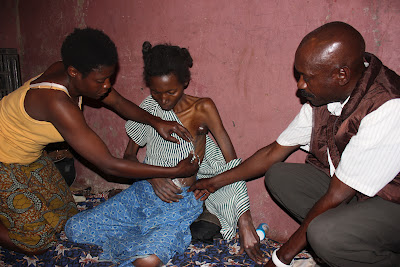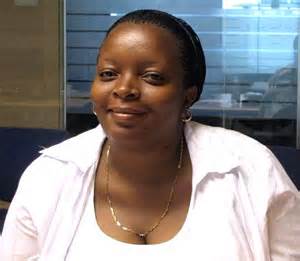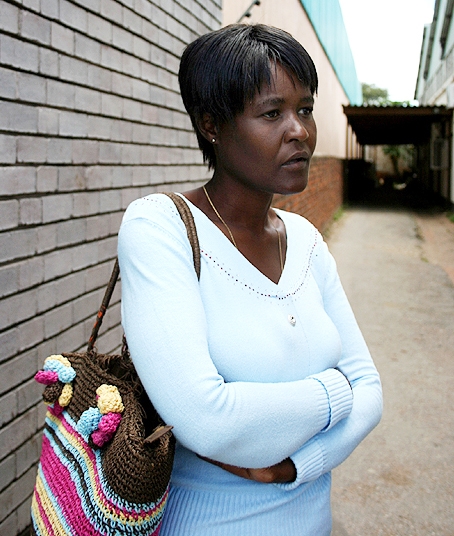Cervical Cancer: A Voice From The Grave
Jan 21, 2015
First story






A Voice From the Grave
Maggie Chisala was 45 years old when she died on August 29, 2012. She had cervical cancer; a disease which Zambian
First Lady Christine Kaseba says is killing over 1300 women per year in the small southern African country. This is a big figure for a country with a population of 14 million people.
Unfortunately, Zambia, like many other African countries, has no cervical cancer policy to give a clear guidance on how to deal with the disease. Dr Kaseba explains that the missing policy is because "many believe if you have cancer there is nothing that can be done for you, and that unfortunately is the belief held by policy makers".
The country also has limited screening facilities, making it practically impossible for most women, particularly those in rural Zambia to know their status. This situation, if allowed to go on, will give birth to another uncontrollable pandemic similar to HIV/AIDS.
Statistics at the World Health Organization show that in Zambia’s case, the mortality rate stands at 38.6 per 100,000, though Dr. Kaseba says “clinically the death rate is even higher with 1,600 deaths out of 1,800 new cases of cervical cancer every year.”
Dr. Kaseba is a gynecologist by profession and runs the Kayula Childhood Cancer Foundation.
She says Zambia is ranked first on cervical cancer mortality rates and last June she warned that the prevalence of the disease will double in the next 20 years if no affirmative action is taken.
Zambia can no longer afford to just talk about cervical cancer and do very little. If the woman is to be saved, screening centers should be opened in all health centers and it should be mandatory for women with HIV to screen for cervical cancer.
According to the World Health Organization, about half a million women worldwide are diagnosed with cervical cancer every year, but most of the 250,000 deaths it causes occur in developing countries, like Zambia, without the infrastructure and resources for routine screening. Women infected with HIV are thought to be three to five times more likely to develop cervical lesions that can become cancerous.
A few brave women, like the late Maggie have dared to share their horrific fight with cervical cancer. In an interview shortly before her demise, this brave Zambian woman took this author through what seemed like a chapter from a horror movie.
Based on that interview and some additional information from Maggie’s sister Dorothy, here is an imaginary letter from Maggie;
“Before I got sick, I lived in Mansa with my husband and five of my nine children. We later moved to Misisi Compound in Lusaka to get closer to medical services.
My story is long but I will try to summarize it. You may be wondering why I would be writing to you from the grave. I have many reasons but this is an attempt to educate women, policy makers and the men too about cervical cancer. I hope my story will move someone to act and maybe save a life or two.
In 2009, I was returning from my little farming field in Mansa’s suburbs area when I was suddenly hit by a cold spell. I suspected the usual Malaria.
Two days later, I was still feeling sick and this time, there was severe pain in my stomach. My husband, Evaristo Chisala, who worked for the Mansa Municipal Council at the time, took me to Mansa General Hospital on the third day.
I was operated on at that hospital and a tumor was removed from my stomach. The doctor kept a piece of that tumor, which was sent to Lusaka to ascertain if it was cancerous. Unfortunately, by the time it reached the Cancer Diseases
Hospital, it was rotten and no tests were done on it.
I still did not feel well a few months after the operation and the doctors in Mansa referred me to the University Teaching Hospital (UTH) in Lusaka for further treatment.
My husband had no money for transport to take me to Lusaka so we waited four months until we had enough to travel. We both had no relatives in the capital city and therefore needed more than just transport money.
At UTH, I learnt that I had stage 3 Cervical Cancer and that the disease had spread to other parts of the body. In particular, my colony was affected.
That was the beginning of the end of my life. I was obviously shocked upon realizing that I was staring death in the face but what worried me most was the welfare of my children. We left them on they own in Mansa, with the eldest, who was 16 at that time, acting as the head of the house. They survived by selling household goods which were left in their care.
The treatment at UTH did not take long and we were back in Mansa in less than two months. However, the pain continued and I travelled back to Lusaka on my own. My husband later followed me and shortly after that, he lost his job. He brought with him three of our youngest children and we had to rent a room in Misisi Compound.
By this time, the part of my stomach which was operated on in Mansa had developed a strange growth which looked like fungi. The growth grew rapidly and before I knew it, my stomach became a big wound.
The doctors at UTH told me that there was nothing much that could be done about my tumor. It turned out, I had several of them. All of them were rapidly growing. One attacked my left breast and the other was right under my right arm pit.
I cannot describe the pain I felt as only a person who has felt it would understand. I reached a point where I could not sleep at all, night or day. I also could not pass human waste normally and a provision was made for me on the side of my stomach by the doctors.
Pain for me became a way of life. That is why when I say I smiled the day I died, I hope you will understand.
I later learnt that all this could have been avoided if I had gone for cervical cancer screening earlier. But then even if I wanted to, I would not have been able to as the only center in Luapula Province was opened in May, 2013. Nine months after I died.
It was a Sunday morning when I died. My stomach wound was bleeding and I was taken to UTH. I had an appointment for Tuesday that same week.
One of the few people who consistently visited me during my final days was Zambian Chapter of the International Community of Women Living with HIV /AIDS Chairperson Clementine Mumba. I was also HIV positive. Doctors say HIV is a leading driver for cervical cancer.
Ms. Mumba explained to me, during those visits, that as HIV positive women our bodies are already fragile and she always mentioned that the government should introduce screening equipment at the Anti-Retro Viral Therapy (ART) Centers to prevent more cervical cancer deaths.
Yes, I am no longer in pain but there is a woman out there who will go through the same ordeal if nothing is done to create cervical cancer awareness and to provide screening centers in every district of Zambia.
I told you that my story was long. I will end here. Hopefully someone out there has learned something from this.
Maggie”
Many more Zambian women will encounter the same ordeal as Maggie if nothing is done to create cervical cancer awareness and to provide screening centers in every district of Zambia.
There are some efforts been put in place, mostly by former U.S President George W. Bush with his Bush Foundation, and the Pink Ribbon Campaign.
This author traveled across Zambia to witness firsthand the problem of cervical cancer and some of the interventions that have been put in place.
Voices from health workers
Livingstone - Dr. Chaila Joseph is a senior resident medical officer at Livingstone General Hospital, currently attached to the department of obstetrics and gynecology, where the cervical cancer clinic is under.
He shares the status of cervical cancer in Zambia’s tourist capital, Livingstone and explains available treatments in Zambia.
“The cervical cancer screening center was opened seven months ago. From that time, over 2200 women have been screened. We also have another center in Livingstone at Mosi-o-Tunya clinic who have screened over 600 since the center was handed over by the Bush family in July, 2013.
Generally in Southern province we have screened over 10500 as of mid-December, (2013) and of that number three percent were found with lesions that were suspected to be cancerous of which most of them were confirmed to be cancers. We also treated about 11 percent of that number, which are about 350. In other words, 1100 were found with pre-cancerous lesions that were treated.
This is a see and treat clinic, you don’t need an appointment, you get counseling and screening, all of which is free. It takes about five minutes at most.
What we do is just to visualize the cervix, we use vinegar, a weaker acid, we apply it for about five minutes then a photo of the cervix is taken. Most women have not seen their cervix. So they have the opportunity to watch everything that we are doing and if we find any abnormalities, we are able to explain while they are seeing. That reduces a bit of patient anxiety.
If we find any lesion, it depends of size, if it is a smaller one, we treat using ice, we use nitrous oxide, we freeze the cervix and the part which is frozen will eventually fall out and a new cervix will grow there. So that way, we are removing the precancerous cells.
If it’s bigger, we do what we call leap, Loop Electro-surgery Procedure. It is quite a short procedure. So whatever samples we get, we send them to Lusaka, where their histology is done and we just communicate the results to the patient. So the removing itself is the treatment, so our women do not have to worry a lot.
Then those that we suspect of cancer, we get a piece to confirm. Treatment depends on the stage. Some we treat them through operations and if it is advanced, we send them to the Cancer Diseases Hospital in Lusaka for chemotherapy or radiotherapy.
If it is very advanced, we might just consider palliative care, where we treat the symptoms that the patient may be presenting and insure that they are as comfortable as possible. At that stage, they cannot be cured.
A driver of cervical cancer in Livingstone, as is also the case in other places, is the high HIV prevalence rate. Cervical cancer is a sexually transmitted infection and it takes years, even up to 20 for it to become a cancer. It has been linked to HIV. So HIV is a larger contributor.
Some of the risk factors to contracting cervical cancer include early exposure to sex, multiple sexual partners and HIV.
Symptoms include lower abdominal pain, backache, pain when having sex and contact bleeding, maybe during sex or when a woman inserts her fingers into her vagina. It also includes abnormal bleeding outside the menstrual cycle as well as vaginal discharge which foul smells. Post-menopausal women who start bleeding should also worry.
Sometimes if the cancer has spread maybe to the lungs, you can have symptoms of chest infection or chest congestion or if it has gone to the other parts of the abdomen, you can feel the masses.
Cervical Cancer has four stages. Stage one is when it is confined to the cervix, stage two is when it attacks the lower vagina and going up, stage three is when it spreads outside the uterus and stage four it goes to the other parts of the body.
Surgical treatment is offered at stage two A where we do what we call radical sterilectomy where the uterus, cervix and part of the vagina as well as other lymph nodes are removed. Then stage two B and above chemotherapy and radiotherapy. For stage four cancer, we offer palliative care.”
Mansa - Mrs Fanny Kasaro Mumba, is a nurse at Mansa General Hospital, Cancer department. She shares the Mansa experience.
“We are the two of us in the cervical cancer screening section and we also have one helper, who is not a nurse.
The problem of cervical cancer in Luapula Province is vast. The province has a population of 979,663 out which 457,653 are women. But we only have one cervical cancer screening center in the whole of Luapula.
The biggest problem that we face is how to get the women to attend screening sessions. We have been carrying out sensitization campaigns within our town but since Mansa itself is small, some few ladies have come but we have been trying to reach out to Mwense, Kawambwa, the out stretches of Luapula Province.
The women are willing to come but they can’t manage since most of them are poor and its very difficult for them to come on their own here.
When we go out for mobile cervical cancer screening, we realize that a lot of people are positive. The only lamentation we have is that they come at a late stage. That is the only time they come.
We had an outreach in December, 2013. We went to Chiengi District. We captured a lot of women of which 66 were positive and most of them LEAP was done and the results are in.
And a lot of them they have these cancer cells. So we thank God that we followed them. They (Ministry of Health) made an effort and gave us transport and we followed the women and treated them.
However, we have not reached most of the women in the province. If you look at Luapula Province, it’s the place where a lot of people come to buy fish. So it is a place that has a lot of people from different places. So when you look at the moral state, it’s not good. A lot of fishermen have a lot of women. Due to that the circulation of these cells is frequent and it moves from one woman to another.
If only we can have a way of reaching out to women, instead of waiting for the mobile hospital. So far we have only travelled once but if we can have our own transport, we can be making arrangements to reach out; it can help a lot of women in Luapula.
Since this center opened on 14th May, 2013, we have screened about 1846. From that number 286 which were positive and from that number, we treated 185 while 151 were referred to the Doctor for further treatment.”
Monze - Mrs. Florence Fundi, is a cervical cancer prevention primary provider at Monze Mission Hospital in Soutthern Province.
“Cervical cancer is quiet a threat in Monze, not just Monze because this site caters for most towns in the southern province. We only have three sites in the province.
The problem is that most of the women come at a late stage, as they come the disease is quiet advanced because they come from faraway places.
It is quite difficult for women in remote areas to come and screen early because our peer educators are just here in Monze. Sometimes they go out with HIV peer educators and sometimes we use the radio. But of course we are aware that most people in the rural areas may not have access to the radio.
During the rainy season the number is a bit down because most of the women are farming but when its busy, we see 15 to 20 women per day, coming to about 100 per week.
We would like to conduct mobile clinics regularly but for that we are waiting for organizations to sponsor us. We want to be as closer to the women as possible. When we go for mobile clinics, they feel they don’t want to miss the opportunity. We see more women out there than at a static site.
The biggest challenge we face is that women come quiet late. Women do not know the importance of screening. That is why they come at an advanced stage. Then there are issues of transport. A woman would not come for screening if she doesn’t have a complaint. But if there was a program where cooperating partners like the chiefs bring women to the center, a lot of them will be saved. The other issue is that most women are busy farming during the rainy season.”
Last words
In the words of late former Press Association of Zambia Vice President Susan Musukuma, who also died from cervical cancer, “cervical cancer is not just a personal tragedy as it affects the whole family and in turn society.
Also to be remembered are the words of another deceased cervical cancer victim, Agnes Mulimbika, a Zambian actress who said "to the women out there, going through what I am going through, I would like to say, 'Be strong and don't pity yourself. Sometimes it's not the disease which is going to kill you, it's self-pity. To other women I would say, 'Go for the tests at least once every year, instead of shunning them'. We should do away with this habit of going to hospital only after you are bedridden, or the condition is critical. When things are detected early, it's good. Even for my cancer, they say when detected early, it's curable."
It must be mentioned that a press query was sent to the Ministry of Health for a comment Zambia’s cervical cancer policy but it has not been responded to. Even after many follow up text and phone calls.
Field work for this story was made possible by the Africa Media Initiative (AMI), which is running the African Story Challenge, where this author is a finalist in the health cycle.




